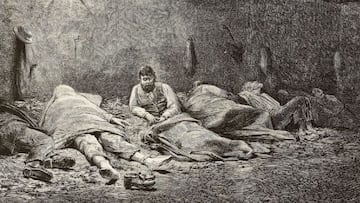Two-phase sleep: bedtime was very different in medieval period
In medieval times, people tended to split their sleep periods into two, dedicating the period between their ‘first sleep’ and ‘second sleep’ to a range of activities.

Sleeping at least eight hours a night is a luxury for some and an impossibility for others. Be it because we don’t have time, want to make the most of the day or are simply unable to drift off, we don’t always get the rest our body needs. Either way, our sleeping habits today are very different to the way they used to be.
Two-phase, or 'biphasic' sleep
Several books and studies reveal that in medieval times, people tended to get their night’s sleep across two separate stints - something which nowadays would be unthinkable.
In his book At Day’s Close: Night in Times Past, Roger Ekirch explains that many people first went to sleep at nightfall - this was before bedtimes had been delayed by the rise in artificial light - then woke up again before midnight. A couple of hours later, they would turn back in until morning. In between the two rest periods, a range of activities would be carried out.
At the beginning of the 1990s, Ekirch came across several testimonies in the Public Record Office in London that he found strange, the BBC reveals. They made reference to a 'first sleep', which suggested that there was also a second sleep. After expanding his search, Ekirch found that this was by no means an isolated reference.
Two-phase or 'biphasic' sleep, as it would come to be described, was common practice at the time. It is mentioned in Geoffrey Chaucer’s Canterbury Tales, written between 1387 and 1400, and has been found in a wide range of other sources, such letters, medical books, diaries and plays.
People would first sleep between around 9pm and 11pm, lying on rudimentary mattresses generally filled with straw or rags, unless they were particularly wealthy and could afford feathers. People normally shared beds, alongside family members, friends and, if travelling, even strangers.
During sleep, it was common to observe a series of social conventions to prevent awkwardness. People were to avoid physical contact or moving around excessively. Meanwhile, each had their own predetermined position in the bed: girls on one side, closest to the wall, followed by the mother and the father. Next, boys in age order, and after that anyone who wasn’t a member of the family.
See also: Could a high-protein diet help you get a deeper sleep?
An in-between period for a range of activities
At around 11pm, people would then wake back up until about 1am. Having had a rest, it was time to complete tasks such as putting wood on the fire, returning to work on the farm or doing household chores. There were even specific Christian prayers for this particular time.
Related stories
This period was also used to socialise and conceive children, Ekirch explains in his book. People might stay in bed chatting, having not had the opportunity to do so while completing their daytime tasks. and as couples had to share their beds with others during their two sleeps, this in-between period was seen as their best chance at intimacy.
Biphasic sleep was not limited to one country in particular: the first sleep was known in Italy as the ‘primo sonno’, and in France as the ‘premier sonne’. Evidence of this practice has also been found in locations such as Africa, southeast Asia and Australia. Ekirch’s research determined that this is how people slept for millennia.

